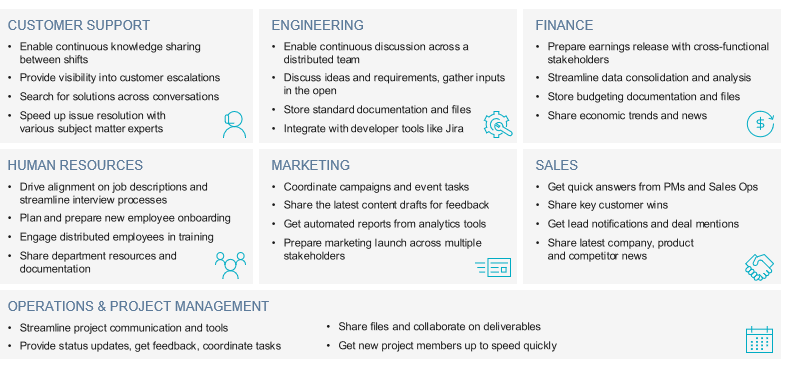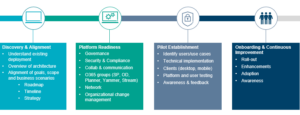Who knew that 2020 would become the Year of the Virtual Workplace? Certainly, the impact of stay-at-home guidelines arising from the global spread of COVID-19 has changed the way the world works. Businesses around the globe have been forced to transform, literally overnight in many cases, to deliver a robust work-from-home platform for workforces of all shapes and sizes. Not surprisingly, Microsoft Teams, which Microsoft has made available for free during this pandemic-driven sea change, has become the go-to tool for successful transitions to a work-from-home environment. In recent days (late March/early April, 2020), Microsoft reported that the Teams platform was seeing a volume of more than 900 million meeting and calling minutes per week, from 44 million users (up from 20 million in November, 2019)!
In a recent webinar, Leveraging Microsoft Teams for Your Remote Workforce (now available on demand), we covered some of the essential steps for a Teams launch. With many organizations just dipping their toes into the Teams waters, and with Protiviti’s expertise and long-standing Microsoft partnership, we have created a primer for a seamless Teams introduction, including some of our most popular best practices for ongoing change management and adoption of this tool.
Our webinar audience, representing more than 1,000 global organizations, was almost evenly split between those who are fully using Teams and those who are just getting started. Most recognize that this tool is allowing their workforce to continue to be as effectively collaborative, if not more so, than in a face-to-face environment. Meetings, live events and person-to-person calls can be conducted on almost any device. Not sure where Microsoft Teams can generate efficiencies? This chart offers a number of practical examples.

It’s all about the people
Getting started with Microsoft Teams can feel daunting, and indeed, some users will balk at the change. We have discovered that a change management approach, breaking the transition into phases, helps companies overcome resistance and encourage adoption. Teams can transform collaboration and communication but only if people USE it. Technical and user readiness planning and implementation need to happen along with building a structure for organizational change management. In addition to having platform readiness, the more important steps should be focused on making sure people are ready for the change.  We like to say “it’s all about the people” when working with clients who are readying a Microsoft Teams launch. We also recommend these best practices:
We like to say “it’s all about the people” when working with clients who are readying a Microsoft Teams launch. We also recommend these best practices:
- Start with a pilot group – this group of early adopters will become the organization’s champions, or cheerleaders, for the full-scale launch. A pilot launch is also an opportunity to identify any technical challenges and resolve system issues that may arise.
- Acknowledge that “shadow IT” solutions will likely exist across the user group. There are many communication and collaboration tools available and users will work with the tools they like best. Take steps to help users feel comfortable with the organization’s preferred solution.
- Recognize that a “deploy it and they will come” approach rarely works well. A sustainable operational plan can maximize results and business outcomes.
Keeping Systems Secure and Compliant
Teams leverages both SharePoint and OneDrive, so the same security and compliance standards that are in effect with those two solutions apply across Teams. Key functionality for maintaining security and compliance includes:

Using Teams, organizations may:
- Put information barriers in place to prevent certain internal teams from communicating with each other, limiting information shared between business segments. This is important for organizations that may be more heavily regulated, such as financial institutions.
- Use information barriers to control communication flow within the organization to avoid conflicts of interest. Examples include:
- An internal team with trade secret material cannot call or chat online with people in certain groups within their organization
- Finance personnel working on confidential company information cannot receive calls from certain groups within their organization
- Use the e-discovery and audit log capabilities to support response to legal inquiries
One of the first questions we hear from clients is: where is my data stored? Here’s a quick breakdown:
- Chat: Stored in the Teams chat service and then a copy of conversations is copied in Exchange for security and compliance; copies of 1:1 chats are stored in a hidden folder in each participant’s mailbox; copies of conversations that take place within a channel are stored in the mailbox of the group attached to the Team; any media is saved in a separate media store.
- Files: Teams leverages SharePoint and OneDrive; a file shared in a group chat or 1:1 is stored in OneDrive for Business – all participants have access; a file shared in a channel is stored in the corresponding SharePoint folder – all Team members have access rights
- Voicemail: Stored in Exchange mailbox; Calendar and Contacts are also stored in Exchange
- Meeting Recording: Initially stored in the same media file used for images, then encoded and stored in Microsoft Stream; recording purged from media store within 24 hours.
- Private Channels: Allows Team owners to further segregate permissions to allow a subset of the users to access conversations and files. Private Channel files are stored in their own separate SharePoint site.
Working from anywhere, seamlessly
With the workforce working mostly remotely, it is important to remain productive, regardless of location or device used. The Team mobile client provides rich functionality that closely mirrors its desktop counterpart.

Source: Protiviti
Some of the unique features of the mobile client are:
- Share location: Being able to share GPS coordinates with maps to colleagues
- Photos: Take pictures that get stored directly in the Team, not the device they are taken from
- Connectivity fallback: Lets users seamlessly switch from Wi-Fi to the cellular network when on calls
- Device Switching: While sharing devices is not an ideal scenario today, it is a common case for front-line workers. A simple single logout mechanism ensures that users access is completely removed when handing over a device to the next person
- Forget passwords: No need to remember yet another password. Teams can issue one-time passwords via SMS.
Planning makes perfect
Organizations have had to respond to the unprecedented challenges created by the global COVID-19 pandemic, specifically how to create a virtual workplace for their people, in a very short time. At a time when IT teams may be asked to respond quickly to avoid business disruptions, Microsoft Teams is a great tool to remain connected and collaborate effectively. Upfront planning will make the effort more successful in the end. So, if 2020 becomes the Year of the Virtual Workplace, your organization is prepared and ready.
More information and resources
For those organizations looking to get started quickly, Protiviti is partnering with Microsoft to help our clients quickly implement Teams to enable a remote and collaborative environment during these changing times. We also offer a complimentary Teams workshop that provides a more detailed overview of the capabilities and value of Teams, along with an analysis and assessment of what is currently in place and a high-level plan to get the organization deployed. Those who are already using Teams may benefit from our on-demand support and training to improve user adoption.
To learn more about our Microsoft consulting solutions, contact us.






